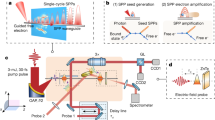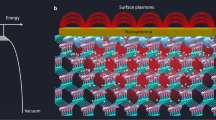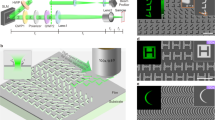Abstract
Surface plasmons have found a broad range of applications in photonic devices at visible and near-infrared wavelengths. In contrast, longer-wavelength surface electromagnetic waves, known as Sommerfeld or Zenneck waves1,2, are characterized by poor confinement to surfaces and are therefore difficult to control using conventional metallo-dielectric plasmonic structures. However, patterning the surface with subwavelength periodic features can markedly reduce the asymptotic surface plasmon frequency, leading to ‘spoof’ surface plasmons3,4 with subwavelength confinement at infrared wavelengths and beyond, which mimic surface plasmons at much shorter wavelengths. We demonstrate that by directly sculpting designer spoof surface plasmon structures that tailor the dispersion of terahertz surface plasmon polaritons on the highly doped semiconductor facets of terahertz quantum cascade lasers, the performance of the lasers can be markedly enhanced. Using a simple one-dimensional grating design, the beam divergence of the lasers was reduced from ∼180° to ∼10°, the directivity was improved by over 10 decibels and the power collection efficiency was increased by a factor of about six compared with the original unpatterned devices. We achieve these improvements without compromising high-temperature performance of the lasers.
This is a preview of subscription content, access via your institution
Access options
Subscribe to this journal
Receive 12 print issues and online access
$259.00 per year
only $21.58 per issue
Buy this article
- Purchase on Springer Link
- Instant access to full article PDF
Prices may be subject to local taxes which are calculated during checkout



Similar content being viewed by others
References
Zenneck, J. Über die Fortpflanzung ebener elektromagnetischer Wellen längs einer ebenen Leiterfläche und ihre Beziehung zur drahtlosen Telegraphie. Ann. Phys. 23, 846–866 (1907).
Sommerfeld, A. Über die Ausbreitung der Wellen in der drahtlosen Telegraphie. Ann. Physik 28, 665–736 (1909).
Pendry, J. B., Martín-Moreno, L. & García-Vidal, F. J. Mimicking surface plasmons with structured surfaces. Science 305, 847–848 (2004).
García-Vidal, F. J., Martín-Moreno, L. & Pendry, J. B. Surfaces with holes in them: New plasmonic metamaterials. J. Opt. A: Pure Appl. Opt. 7, S97–S101 (2005).
Engheta, N. & Ziolkowski, R. W. Metamaterials: Physics and Engineering Explorations (Wiley-IEEE Press, 2006).
Cai, W. & Shalaev, V. M. Optical Metamaterials: Fundamentals and Applications (Springer, 2009).
Pendry, J. B., Schurig, D. & Smith, D. R. Controlling electromagnetic fields. Science 312, 1780–1782 (2006).
Leonhardt, U. Optical conformal mapping. Science 312, 1777–1780 (2006).
Smolyaninov, I. I., Hung, Y-J. & Davis, C. C. Imaging and focusing properties of plasmonic metamaterial devices. Phys. Rev. B 76, 205424 (2007).
Beermann, J., Radko, I. P., Boltasseva, A. & Bozhevolnyi, S. I. Localized field enhancements in fractal shaped periodic metal nanostructures. Opt. Express 15, 15234–15241 (2007).
Radko, I. P. et al. Plasmonic metasurfaces for waveguiding and field enhancement. Laser Photon. Rev. 3, 575–590 (2009).
Navarro-Cía, M. et al. Broadband spoof plasmons and subwavelength electromagnetic energy confinement on ultrathin metafilms. Opt. Express 17, 18184–18195 (2009).
Gan, Q., Fu, Z., Ding, Y. J. & Bartoli, F. J. Ultrawide-bandwidth slow-light system based on THz plasmonic graded metallic grating structures. Phys. Rev. Lett. 100, 256803 (2008).
Williams, C. R. et al. Highly confined guiding of terahertz surface plasmon polaritons on structured metal surfaces. Nature Photon. 2, 175–179 (2008).
Hajenius, M. et al. Surface plasmon quantum cascade lasers as terahertz local oscillators. Opt. Lett. 33, 312–314 (2008).
Kim, S. M. et al. Biomedical terahertz imaging with a quantum cascade laser. Appl. Phys. Lett. 88, 153903 (2006).
Lee, A. W. M. et al. Real-time terahertz imaging over a standoff distance (>25 meters). Appl. Phys. Lett. 89, 141125 (2006).
Hübers, H-W. et al. High-resolution gas phase spectroscopy with a distributed feedback terahertz quantum cascade laser. Appl. Phys. Lett. 89, 061115 (2006).
Belkin, M. A. et al. High-temperature operation of terahertz quantum cascade laser sources. IEEE J. Sel. Top. Quantum Electron. 15, 952–967 (2009).
Williams, B. S. Terahertz quantum-cascade lasers. Nature Photon. 1, 517–525 (2007).
Scalari, G. et al. THz and sub-THz quantum cascade lasers. Laser Photon. Rev. 3, 45–66 (2009).
Lee, A. W. M. et al. High-power and high-temperature THz quantum-cascade lasers based on lens-coupled metal–metal waveguides. Opt. Lett. 32, 2840–2842 (2007).
Amanti, M. I., Fischer, M., Walther, C., Scalari, G. & Faist, J. Horn antennas for terahertz quantum cascade lasers. Electron. Lett. 43, 573–574 (2007).
Fan, J. A. et al. Surface emitting terahertz quantum cascade laser with a double-metal waveguide. Opt. Express 14, 11672–11680 (2006).
Mahler, L. et al. Vertically emitting microdisk lasers. Nature Photon. 3, 46–49 (2009).
Amanti, M. I., Fischer, M., Scalari, G., Beck, M. & Faist, J. Low-divergence single-mode terahertz quantum cascade laser. Nature Photon. 3, 586–590 (2009).
Chassagneux, Y. et al. Electrically pumped photonic-crystal terahertz lasers controlled by boundary conditions. Nature 457, 174–178 (2009).
Yu, N. et al. Plasmonics for laser beam shaping. IEEE Trans. Nanotech. 9, 11–29 (2010).
Yu, N. et al. Small-divergence semiconductor lasers by plasmonic collimation. Nature Photon. 2, 564–570 (2008).
Yu, N. et al. Semiconductor lasers with integrated plasmonic polarizers. Appl. Phys. Lett. 94, 151101 (2009).
Yu, N. et al. Multi-beam multi-wavelength semiconductor lasers. Appl. Phys. Lett. 95, 161108 (2009).
Stutzman, W. L. & Thiele, G. A. Antenna Theory and Design (John Wiley, 1981).
Wang, B., Liu, L. & He, S. Propagation loss of terahertz surface plasmon polaritons on a periodically structured Ag surface. J. Appl. Phys. 104, 103531 (2008).
Gaidis, M. C. et al. A 2.5-THz receiver front end for spaceborne applications. IEEE Trans. Microw. Theory Tech. 48, 733–739 (2000).
Siegel, P. H. & Dengler, R. J. The dielectric-filled parabola: A new millimetre/submillimetre wavelength receiver/transmitter front end. IEEE Trans. Antennas Propag. 39, 40–47 (1991).
Belkin, M. A. et al. Int. Workshop on Optical Terahertz Science and Technology Talk TuC5, Santa Barbara (2009).
Adam, A. J. L. et al. Beam patterns of terahertz quantum cascade lasers with subwavelength cavity dimensions. Appl. Phys. Lett. 88, 151105 (2006).
Orlova, E. E. et al. Antenna model for wire lasers. Phys. Rev. Lett. 96, 173904 (2006).
Fan, J. A. et al. Wide-ridge metal–metal terahertz quantum cascade lasers with high-order lateral mode suppression. Appl. Phys. Lett. 92, 031106 (2008).
Huggard, P. G. et al. Drude conductivity of highly doped GaAs at terahertz frequencies. J. Appl. Phys. 87, 2382–2385 (2000).
Walukiewicz, W., Lagowski, L., Jastrzebski, L., Lichtensteiger, M. & Gatos, H. C. Electron mobility and free-carrier absorption in GaAs: Determination of the compensation ratio. J. Appl. Phys. 50, 899–908 (1979).
Adachi, S. GaAs and Related Materials: Bulk Semiconducting and Superlattice Properties (World Scientific Publishing Company, 1994).
Acknowledgements
We gratefully acknowledge constructive and helpful discussions with R. Blanchard, C. Pflügl, L. Diehl and A. Belyanin. M.A.K. is supported by the National Science Foundation through a Graduate Research Fellowship. We would like to thank N. Antoniou for assistance in FIB milling. We acknowledge support from AFOSR under contract No. FA9550-09-0505-DOD and the EPSRC (UK). The authors acknowledge the Center for Nanoscale Systems (CNS) at Harvard University. Harvard CNS is a member of the National Nanotechnology Infrastructure Network (NNIN). The computations in this Letter were run on the Odyssey cluster supported by the Harvard Faculty of Arts and Sciences (FAS) Sciences Division Research Computing Group.
Author information
Authors and Affiliations
Contributions
N.Y. designed the devices, in collaboration with J.A.F., and, with Q.J.W., fabricated them and carried out the experiments. M.A.K. participated in the device simulation and in the data analysis. S.P.K. and L.L. grew QCL material using molecular beam epitaxy. N.Y. and F.C. wrote the paper. F.C., A.G.D. and E.H.L. supervised the project.
Corresponding authors
Ethics declarations
Competing interests
The authors declare no competing financial interests.
Supplementary information
Supplementary Information
Supplementary Information (PDF 909 kb)
Rights and permissions
About this article
Cite this article
Yu, N., Wang, Q., Kats, M. et al. Designer spoof surface plasmon structures collimate terahertz laser beams. Nature Mater 9, 730–735 (2010). https://doi.org/10.1038/nmat2822
Received:
Accepted:
Published:
Issue Date:
DOI: https://doi.org/10.1038/nmat2822
This article is cited by
-
Optically and radiofrequency-transparent metadevices based on quasi-one-dimensional surface plasmon polariton structures
Nature Electronics (2023)
-
High-frequency rectifiers based on type-II Dirac fermions
Nature Communications (2021)
-
A plasmonic route for the integrated wireless communication of subdiffraction-limited signals
Light: Science & Applications (2020)
-
Wideband Miniaturized Design of Complementary Spoof Surface Plasmon Polaritons Waveguide Based on Interdigital Structures
Scientific Reports (2020)
-
Integrated multi-scheme digital modulations of spoof surface plasmon polaritons
Science China Information Sciences (2020)



